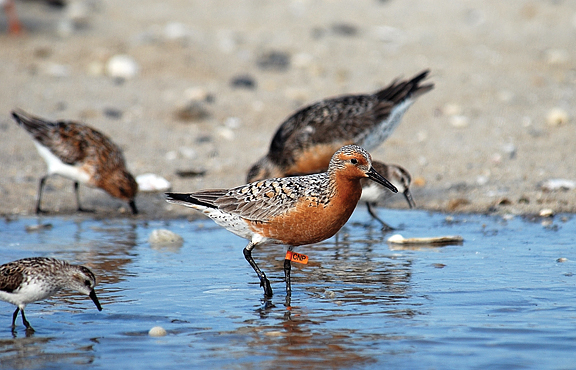County and state officials are prepared to take necessary precautions to accommodate the new federally protected rufa red knot, a small shorebird spotted at Masons Inlet and Masonboro Inlet each spring and fall.
The red knot will be protected under the Endangered Species Act beginning Jan. 12, 30 days after the bird’s official listing in the federal register of threatened and endangered species. U.S. Fish and Wildlife Service is expected to announce areas essential for conservation of the red knot, or critical habitat, in 2015. The designations will be subject to public review and comment before becoming official.
Walker Golder, Audubon North Carolina deputy director, said inlets and barrier islands along the North Carolina coast are important stops where red knots rest and fatten up while tackling long migrations, sometimes from areas as far-flung as southern South America to the Arctic. He listed Rich’s Inlet and Lea-Hutaff Island as particularly important areas for the red knot, but said the birds are also known visitors to the Wrightsville Beach area, most commonly in May. Audubon North Carolina has kept a close eye on the red knot for about 15 years, Golder said.
As a threatened species, Fish and Wildlife Service is expected to consider the red knot when outlining requirements and restrictions in U.S. Army Corps of Engineers permits awarded for beach and inlet management projects.
New Hanover County Shore Protection Coordinator Layton Bedsole said he has anticipated threatened status for the red knot for nearly two years.
“They’ve been on our radar for years. We’ve been including them in any environmental documentation,” Bedsole said.
Preparations for the red knot’s designation were also underway at the state level, said N.C. Department of Environment and Natural Resources spokesperson Michele Walker. The red knot is included in a not-yet-completed internal study of protected species along the coast. The study, Walker said, will help N.C. Division of Coastal Management staff know how to identify the red knot and which beaches the bird uses to grant conditions for future Coastal Area Management Act (CAMA) major permits.
“We knew this was going to be coming,” Walker said.
The bird has been a candidate for protection under the Endangered Species Act since 2006, following an approximately 75 percent population loss over the last 35 years due to scarcity of food and the changing climate of its breeding habitat in the Arctic.
email [email protected]




